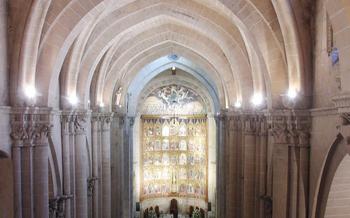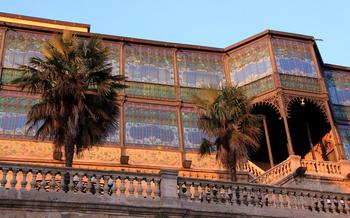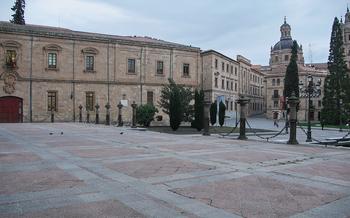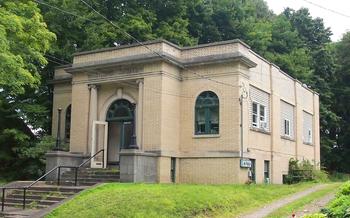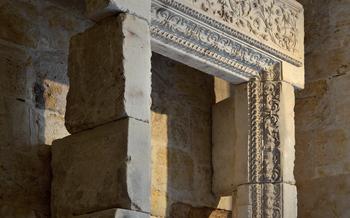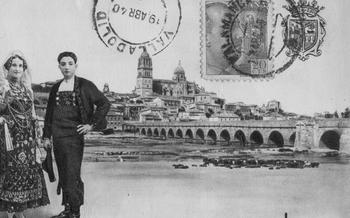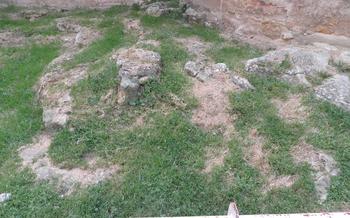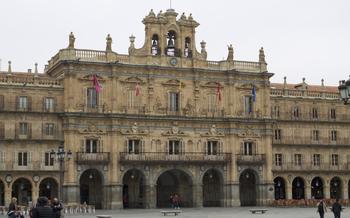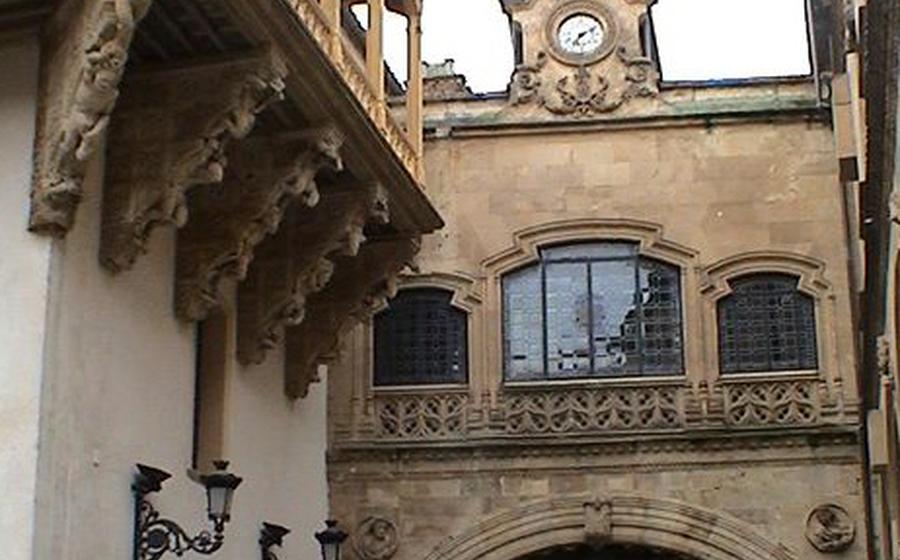
Salina Plaza
- Plaza Mayor
- Salamanca Cathedral
- University of Salamanca
- Casa de las Conchas
- Museo de Art Nouveau y Art Déco
- Convento de San Esteban: A Realm of Architectural Grandeur and Religious Devotion
- Puente Romano
- Cueva de Salamanca
- Parque de la Alamedilla: A Haven of Tranquility in the City's Heart
- Mercado Central: A Culinary Adventure in the Heart of Salamanca
- Casa Lis: A Journey Through Art Nouveau and Art Deco
- Iglesia de San Martín: A Blend of Architectural Styles
- Palacio de Monterrey
- Insider Tip: Exploring the Hidden Treasures of Salamanca
Plaza Mayor
The Plaza Mayor of Salamanca is the beating heart of the city, a grand square that exudes history, culture, and architectural splendor. Built in the 18th century, it stands as a testament to the city's rich past and its enduring significance. The square's unique design, with its four sides surrounded by elegant arcaded buildings, has earned it the title of "the most beautiful square in Spain" and a designation as a UNESCO World Heritage Site.
The Plaza Mayor is not just a historical landmark but also a vibrant hub of activity. Throughout the year, it hosts a multitude of cultural events, from lively concerts and theater performances to traditional festivals and markets. During the day, the square is a popular gathering place for locals and tourists alike, who come to relax on the benches, admire the intricate facades, or simply soak up the lively atmosphere. As the sun sets, the square transforms into a magical space, with the soft glow of the streetlights illuminating its architectural details and casting a warm ambiance over the entire plaza.
Salamanca Cathedral
The Salamanca Cathedral, officially known as the Cathedral of Santa María de la Sede, is a stunning testament to Gothic architectural mastery. Its construction began in the 12th century and continued for over two centuries, resulting in a harmonious blend of Romanesque, Gothic, and Renaissance styles. The cathedral's imposing façade is adorned with intricate carvings depicting scenes from the Bible, while its interior boasts breathtaking vaulted ceilings, elegant stained-glass windows, and a magnificent altarpiece.
Highlights of the Interior:
Altarpiece: The cathedral's altarpiece is an awe-inspiring masterpiece of Gothic art, created by the renowned artist Nicolás Florentino in the 15th century. It consists of over 50 carved panels depicting scenes from the life of Christ and the Virgin Mary, along with intricate details and vibrant colors.
Choir: The choir, located in the center of the cathedral, is a marvel of Gothic craftsmanship. Its intricately carved wooden stalls feature scenes from the Old and New Testaments, as well as depictions of mythical creatures and everyday life. The choir is considered one of the finest examples of its kind in Spain.
Cloister: The cathedral's cloister is a serene oasis, providing a tranquil retreat from the bustling city. Its graceful arches, delicate tracery, and lush greenery create a harmonious and contemplative atmosphere. The cloister is a popular spot for visitors to relax and soak in the cathedral's tranquil beauty.
Climbing the Tower:
For those seeking breathtaking views of Salamanca, the cathedral's tower offers an unforgettable experience. Visitors can climb the 223 steps to the top of the tower, where they are rewarded with panoramic vistas of the city's historic center, the surrounding countryside, and the meandering Tormes River. The climb is well worth the effort, providing an unparalleled perspective on Salamanca's architectural treasures.
Legends and Facts:
-
Witchcraft and Magic: The cathedral is associated with legends of witchcraft and magic, particularly due to its proximity to the Cueva de Salamanca, a cave rumored to have been a gathering place for witches and sorcerers.
-
Astronomical Clock: The cathedral's astronomical clock is a marvel of medieval engineering. It dates back to the 15th century and features moving figures that represent the Earth, the Moon, and the Sun, along with other celestial bodies.
-
Hidden Door: The cathedral's exterior features a hidden door known as the "Puerta de los Perdones" (Door of Forgiveness). Legend has it that prisoners who managed to reach this door would be granted pardon for their crimes.
University of Salamanca
The University of Salamanca, founded in 1218, is one of the oldest universities in the world and a UNESCO World Heritage Site. Its stunning plateresque façade, adorned with intricate carvings and sculptures, is a testament to the city's rich history and cultural heritage.
Exploring the university's historic buildings and courtyards is like stepping back in time. The Patio de Escuelas Menores, with its elegant arcades and central fountain, provides a glimpse into the university's early days. The Patio de Escuelas Mayores, with its grand staircase and ornate decorations, is a masterpiece of Renaissance architecture.
Salamanca is a vibrant student city, and the university plays a central role in its cultural and social life. Students from all over the world come to study here, creating a diverse and cosmopolitan atmosphere. The university also hosts numerous cultural events, lectures, and exhibitions throughout the year, making it a hub of intellectual and artistic activity.
In addition to its academic and cultural significance, the University of Salamanca is also known for its unique traditions. The most famous of these is the "Nochevieja Universitaria," or University New Year's Eve, which is celebrated on December 31st. On this night, students gather in the Plaza Mayor to eat 12 grapes at midnight, symbolizing good luck for the coming year.
I had the opportunity to visit the University of Salamanca during my stay in the city. I was particularly impressed by the beauty of the plateresque façade and the grandeur of the Patio de Escuelas Mayores. I also enjoyed exploring the university's historic buildings and courtyards, and learning about its rich history and traditions.
Casa de las Conchas
The Casa de las Conchas, or "House of Shells," stands as a unique and captivating landmark in Salamanca. Its façade, adorned with over 300 intricately carved seashells, immediately draws the eye and sparks curiosity. The shells, believed to represent the pilgrimage of its original owner to the shores of Santiago de Compostela, lend the building an air of mystery and intrigue.
Originally constructed in the 15th century, the Casa de las Conchas has a rich history. It served as a residence for wealthy families, a university college, and even a prison before becoming a public library in the early 20th century. The library's collection boasts over 50,000 volumes, specializing in local history and culture.
Visiting the Casa de las Conchas is a delightful experience. As you step inside, you'll be greeted by a stunning courtyard with an ornate fountain and intricate carvings. The library's reading rooms, housed in the building's historic halls, offer a serene and scholarly atmosphere.
Don't miss the opportunity to explore the building's upper floors, where you'll find exhibits on the history of the Casa de las Conchas and the city of Salamanca. The rooftop terrace offers breathtaking panoramic views of the city, making it the perfect spot to end your visit.
In my personal experience, visiting the Casa de las Conchas was a captivating journey through history and architecture. I spent hours wandering through the building, admiring the intricate details of the seashells and learning about the lives of those who had once called this place home. The Casa de las Conchas is a true gem of Salamanca, and I highly recommend it to anyone visiting this beautiful city.
Museo de Art Nouveau y Art Déco
The Museo de Art Nouveau y Art Déco, located in the heart of Salamanca, is a treasure trove of decorative arts from the late 19th and early 20th centuries. Housed in a beautiful modernist building, the museum showcases a diverse collection of furniture, glass, ceramics, jewelry, and paintings.
As I stepped into the museum, I was immediately captivated by the stunning collection of Art Nouveau pieces. The sinuous lines, floral motifs, and vibrant colors of the furniture and objects seemed to transport me back in time to a bygone era of elegance and artistry. I particularly admired a delicate stained-glass lamp with intricate floral patterns that cast a warm glow on the surrounding exhibits.
The Art Deco section of the museum was equally impressive, with its bold geometric forms and luxurious materials. I was drawn to a striking bronze sculpture of a dancer, its sleek lines and stylized features embodying the essence of the Art Deco aesthetic. The collection also included exquisite examples of jewelry, glassware, and ceramics, each piece a testament to the skill and creativity of the era's artisans.
Throughout the museum, I found myself marveling at the sheer variety and quality of the objects on display. From the intricate marquetry of a cabinet to the delicate porcelain of a tea set, every item seemed to tell a story about the history of decorative arts and the evolution of design.
My personal highlight of the museum was a stunning stained-glass window depicting a scene from nature. The vibrant colors and intricate details of the window created a sense of wonder and awe, reminding me of the power of art to transcend time and space.
If you're a fan of decorative arts, the Museo de Art Nouveau y Art Déco is an absolute must-visit. Its rich collection offers a glimpse into the creativity and artistry of a bygone era, leaving you with a deep appreciation for the beauty and craftsmanship of the past.
Convento de San Esteban: A Realm of Architectural Grandeur and Religious Devotion
The Convento de San Esteban stands as a testament to the Dominican Order's profound influence on Salamanca's spiritual and architectural landscape. Founded in the 13th century, this awe-inspiring complex has undergone several transformations over the centuries, blending Gothic and Renaissance elements into a harmonious masterpiece.
As you step through its grand entrance, you'll be greeted by the Gothic cloister, an oasis of tranquility adorned with intricate carvings and delicate arches. The serene atmosphere invites contemplation and reflection, transporting you back to a time when monks sought solace and communion within these sacred walls.
Continuing your exploration, you'll encounter the stunning Renaissance façade, a testament to the artistic prowess of the 16th century. Its intricate details, including medallions, friezes, and biblical scenes, narrate the life of Christ and the Dominican Order's unwavering faith.
Inside the convent, you'll be captivated by the opulence and grandeur of the interior. The altarpiece, a masterpiece of woodcarving, depicts scenes from the life of Saint Stephen, the convent's patron saint. The choir, with its intricately carved stalls, provides a glimpse into the daily lives of the monks who once chanted prayers and hymns within these hallowed halls.
The sacristy, a treasure trove of religious artifacts, showcases exquisite gold and silverwork, intricate tapestries, and precious relics. Each piece tells a story of devotion, sacrifice, and the enduring legacy of the Dominican Order.
Visiting the Convento de San Esteban is an immersive experience that transports you to a bygone era, where faith, art, and architecture converged to create a sacred sanctuary. It's a place where you can connect with the spiritual essence of Salamanca and marvel at the enduring power of human devotion.
Puente Romano
The Puente Romano, or Roman Bridge, is an architectural marvel that has stood the test of time in Salamanca. Built by the Romans in the 1st century AD, this bridge spans the Tormes River and connects the historic city center to the countryside beyond. Its impressive structure features 26 semicircular arches, each adorned with unique Romanesque details. The bridge's fortified towers, strategically positioned at each end, add to its grandeur and historical significance.
Crossing the Puente Romano is an experience that transports visitors back in time. The worn stone beneath your feet, the gentle sound of the river flowing below, and the stunning views of the surrounding landscape create a magical ambiance. The bridge's strategic location has long served as a vital connection between the city and its rural surroundings, facilitating trade, travel, and cultural exchange.
In the early morning light, the bridge takes on a golden hue, casting a warm glow over the tranquil waters of the Tormes. As the sun sets, the sky transforms into a canvas of vibrant colors, reflecting beautifully on the ancient stone. Whether you're strolling across the bridge during the day or marveling at its illuminated beauty at night, the Puente Romano offers a captivating experience that will leave a lasting impression.
Personal Anecdote:
I remember my first encounter with the Puente Romano vividly. As I approached the bridge, I was struck by its sheer size and grandeur. The sun was setting, casting a warm golden glow over the ancient stone. I took a deep breath and stepped onto the bridge, feeling a sense of awe and wonder.
As I crossed the bridge, I couldn't help but imagine the countless people who had walked this path before me. Roman soldiers, traders, pilgrims, and travelers of all kinds had crossed this bridge throughout history. I thought about the stories they could tell, the journeys they had undertaken, and the lives they had lived.
Reaching the other side of the bridge, I turned around to take one last look. The Puente Romano stood tall and proud, a testament to the enduring legacy of the Roman Empire. It was a moment of pure enchantment, and I knew I would never forget the experience.
Cueva de Salamanca
Legends and Myths of Witchcraft and Magic
The Cueva de Salamanca, also known as the Cave of Salamanca, is steeped in legends and myths that have captivated the imaginations of locals and visitors alike for centuries. According to one legend, the cave was once home to a school of magic, where students learned the secrets of witchcraft and sorcery. It was said that the devil himself taught classes in the cave, and that students who successfully completed their studies would be granted incredible powers.
Another legend tells the tale of a young woman named Salamanca who was imprisoned in the cave by her father, who feared her magical abilities. Salamanca eventually escaped from the cave with the help of a friendly demon, and she went on to become a powerful and respected witch.
Historical Significance and Spiritual Practices
Beyond its mythical associations, the Cueva de Salamanca also holds historical significance as a place of pilgrimage and spiritual practices. In the Middle Ages, the cave was a popular destination for pilgrims who sought healing and guidance from the spirits that were said to reside there. People would often leave offerings in the cave, such as candles, flowers, and food, in hopes of receiving blessings or favors.
Current Status and Accessibility
Today, the Cueva de Salamanca is open to visitors who wish to explore its mysterious depths. The cave is located on the outskirts of the city, and it can be reached by foot or by bus. Visitors can wander through the cave's chambers and tunnels, and they can even see the remnants of the school of magic that is said to have once existed there.
Personal Anecdotes
During my visit to Salamanca, I made sure to explore the Cueva de Salamanca. I was immediately struck by the cave's eerie and mysterious atmosphere. As I walked through the dark tunnels, I couldn't help but feel a sense of awe and wonder. I imagined what it would have been like to study magic in the cave centuries ago, and I felt a deep connection to the legends and myths that surround this fascinating place.
Parque de la Alamedilla: A Haven of Tranquility in the City's Heart
In the heart of Salamanca, nestled amidst the vibrant cityscape, lies the picturesque Parque de la Alamedilla, a verdant oasis that offers a respite from the bustling streets. With its lush gardens, cascading fountains, and elegant monuments, the park is a sanctuary of tranquility and a beloved gathering place for locals and tourists alike.
Established in the 19th century, the Parque de la Alamedilla has played a significant role in the urban fabric of Salamanca. It was designed by the renowned architect Daniel Zuloaga, who envisioned a green space that would provide a haven for relaxation and recreation in the growing city. Over the years, the park has undergone several renovations and expansions, each adding to its charm and functionality.
Today, the Parque de la Alamedilla boasts a diverse array of attractions that cater to visitors of all ages. As you step into the park, you are greeted by a majestic fountain, surrounded by colorful flower beds and manicured lawns. The park's pathways meander through groves of towering trees, offering shade and seclusion for those seeking a peaceful retreat.
Amidst the verdant landscape, you will find several monuments and sculptures that pay homage to Salamanca's rich history and culture. The most notable among them is the statue of Miguel de Unamuno, the renowned Spanish philosopher and writer who was a professor at the University of Salamanca. Other notable monuments include the bust of the poet José María Gabriel y Galán and the monument to the victims of the Spanish Civil War.
The Parque de la Alamedilla is not just a place for quiet contemplation but also a hub of activity and entertainment. During the summer months, the park comes alive with concerts, theater performances, and outdoor exhibitions, attracting locals and tourists alike. The park also features a playground for children, making it a popular destination for families.
Whether you seek a tranquil escape from the city's hustle and bustle, a place to enjoy a leisurely picnic, or a vibrant space to witness cultural events, the Parque de la Alamedilla has something to offer everyone. As you stroll through its serene pathways, you will discover a hidden gem that encapsulates the essence of Salamanca's charm and beauty.
Mercado Central: A Culinary Adventure in the Heart of Salamanca
Located in the heart of Salamanca, the Mercado Central is a vibrant and bustling hub of local produce, gastronomy, and cultural exchange. Step inside this historic market and be greeted by a symphony of colors, aromas, and flavors that will awaken your senses.
The market is divided into different sections, each dedicated to a specific type of food. From fresh fruits and vegetables to locally sourced meats, cheeses, and seafood, the Mercado Central offers a tantalizing array of culinary delights. Browse the stalls, interact with the friendly vendors, and let their passion for food guide you in your culinary discoveries.
One of the highlights of the market is the pescadería, or fish market. Here, you'll find a dazzling display of freshly caught seafood, from glistening sardines and plump shrimp to succulent lobsters and sea bass. The air is filled with the briny scent of the sea, and the vendors are more than happy to share their knowledge and recommend the best catches of the day.
In the charcutería, or meat section, you'll find a tempting selection of cured hams, sausages, and other local delicacies. The aroma of smoked meats and spices fills the air, and it's hard to resist sampling some of these delectable treats. Don't miss the opportunity to try the famous jamón ibérico, a prized Spanish ham known for its rich and nutty flavor.
The Mercado Central is not just about food; it's also a place to experience the vibrant culture of Salamanca. As you wander through the market, take a moment to observe the locals going about their daily lives, chatting with the vendors, and selecting the freshest ingredients for their meals. The market is a true melting pot of cultures, where locals and tourists alike come together to celebrate the joys of food and community.
So, if you're looking for an authentic and immersive culinary experience in Salamanca, be sure to visit the Mercado Central. Let your taste buds guide you as you explore the market's hidden gems and discover the flavors that make this city so special.
Casa Lis: A Journey Through Art Nouveau and Art Deco
Nestled in the heart of Salamanca, Casa Lis stands as a testament to the city's rich cultural heritage. This magnificent Art Nouveau building, constructed in the early 20th century, was once the residence of the Lis family, prominent figures in the city's history. Today, it houses the Art Nouveau and Art Deco Museum, inviting visitors to embark on a journey through these captivating artistic movements.
As you step inside Casa Lis, you'll be greeted by an impressive collection of Art Nouveau and Art Deco artifacts, meticulously arranged to showcase their unique styles and influences. From furniture to glasswork, ceramics to textiles, the museum offers a comprehensive exploration of these artistic periods.
Among the highlights of the collection are exquisite pieces of furniture, adorned with intricate carvings and sinuous lines that embody the essence of Art Nouveau. The museum also features a remarkable collection of stained glass windows, casting colorful hues throughout the rooms and creating a magical atmosphere.
Take your time to wander through the different sections of the museum, discovering hidden treasures and learning about the history and techniques behind these captivating art forms. Immerse yourself in the world of Art Nouveau and Art Deco, and allow yourself to be transported back in time to an era of elegance and innovation.
My personal experience at Casa Lis was truly memorable. I was particularly drawn to the collection of ceramics, with its delicate shapes and vibrant colors. Each piece seemed to tell a story, inviting me to imagine the hands that crafted them and the lives they had touched.
As I explored the museum, I couldn't help but admire the vision and dedication of the Lis family, who transformed their home into a living testament to their passion for art and beauty. Casa Lis is a true gem in Salamanca, a place where history, art, and creativity converge to create a captivating experience for visitors from around the world.
Iglesia de San Martín: A Blend of Architectural Styles
In the heart of Salamanca's historic center, stands the Iglesia de San Martín, a testament to the city's rich architectural heritage. Founded in the 12th century, the church boasts a unique blend of Romanesque, Mudejar, and Gothic elements, reflecting its long and storied history.
The exterior façade, with its sturdy Romanesque arches and intricate carvings, immediately captivates the eye. Its simplicity contrasts beautifully with the delicate Mudejar tower, adorned with intricate brickwork and ceramic tiles. This tower, a symbol of Islamic influence in the region, adds a touch of elegance and charm to the overall structure.
Stepping inside the church, one is greeted by a sense of awe and wonder. The interior is a testament to the skill and artistry of medieval craftsmen. The altarpiece, a masterpiece of Gothic art, features intricate carvings depicting scenes from the life of Christ. The choir, with its finely crafted wooden stalls, is a testament to the church's musical heritage, while the crypt, with its ancient tombs and ossuaries, offers a glimpse into the church's past.
Visiting the Iglesia de San Martín is a journey through time, allowing visitors to experience the evolution of architectural styles and the rich history that has shaped Salamanca. Its unique blend of Romanesque, Mudejar, and Gothic elements makes it a must-visit destination for anyone interested in the city's cultural heritage.
Personal Anecdote:
During my visit to Salamanca, I stumbled upon the Iglesia de San Martín while exploring the city's backstreets. Intrigued by its unique façade, I decided to step inside. As I crossed the threshold, I was transported back in time. The church's interior, with its blend of architectural styles and sacred atmosphere, left me in awe. I spent hours exploring the intricate details of the altarpiece, admiring the delicate carvings of the choir, and contemplating the history that lay beneath my feet in the crypt. The Iglesia de San Martín is a hidden gem, waiting to be discovered by those willing to venture off the beaten path.
Palacio de Monterrey
Located in the heart of Salamanca's historic center, the Palacio de Monterrey is a magnificent Renaissance palace that exudes grandeur and historical significance. Built in the 16th century by the powerful Monterrey family, the palace boasts impressive architecture and ornate interiors that transport visitors back in time.
Exploring the palace's grand courtyard is a must. Surrounded by elegant arcades and adorned with intricate carvings, the courtyard sets the stage for the splendor that awaits within. The grand staircase, with its sweeping curves and ornate balustrades, is another highlight, leading visitors to the palace's opulent upper floors.
Inside, visitors can marvel at the palace's beautifully preserved rooms, each adorned with unique frescoes, tapestries, and furniture. The library, with its vast collection of rare books and manuscripts, is a treasure trove for history and literature enthusiasts.
For a truly immersive experience, visitors can book a guided tour of the palace, which provides insights into the history of the Monterrey family, the palace's construction, and the significance of its architectural features.
My personal visit to the Palacio de Monterrey was a memorable one. I was particularly struck by the palace's intricate plateresque façade, which is a masterpiece of Renaissance craftsmanship. The interior was equally impressive, with each room showcasing unique works of art and historical artifacts.
Exploring the palace felt like stepping into a different era, and I couldn't help but imagine the lavish parties and gatherings that must have taken place within its walls centuries ago. The Palacio de Monterrey is a testament to the grandeur and opulence of Salamanca's past, and it remains a must-visit attraction for anyone interested in history, architecture, and culture.
Insider Tip: Exploring the Hidden Treasures of Salamanca
Beyond the well-trodden tourist paths, Salamanca holds a treasure trove of hidden gems waiting to be discovered. One such gem is the Patio de Escuelas Menores, a secluded courtyard nestled within the historic university complex. Step through an unassuming doorway, and you'll find yourself transported to a tranquil oasis, surrounded by elegant Renaissance architecture. Admire the intricate carvings, soak in the peaceful atmosphere, and feel like you've stumbled upon a secret world.
This hidden courtyard is a testament to Salamanca's rich history and cultural heritage. Once a center of learning for students from across Europe, the university complex is now a UNESCO World Heritage Site, and the Patio de Escuelas Menores is one of its most enchanting hidden corners. Take a moment to pause and appreciate the beauty of this secluded spot, and you'll feel like you've truly discovered a hidden treasure in the heart of Salamanca.
